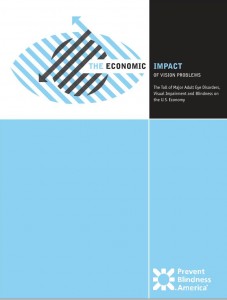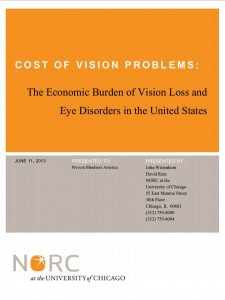5/6/14
**Update 6/16/14 – New estimate on the cost of vision problems just came out in the new Prevent Blindness America report showing they could reach $717 billion by 2050.
This past week I attended a dinner where a topic of discussion was the cost of chronic disease on healthcare – 75% of healthcare dollars go to the treatment of chronic diseases. This led me to explore the costs chronic eye diseases such as age-related macular degeneration, cataract, glaucoma and diabetic retinopathy.

In 2007 Prevent Blindness America (PBA) published a report, The Economic Impact of Vision Problems that was updated in 2012, which explored the economic burden related to people 40 and older and the conditions of, age-related macular degeneration (AMD), cataract, diabetic retinopathy, primary open-angle glaucoma and refractive error, as well as the economic impact of vision problems and blindness.
They looked at direct medical costs including inpatient, outpatient and prescription costs; direct non-medical costs, which include nursing home care, guide dogs, and government programs for the blind and visually impaired; and loss of productivity, which includes lower labor force participation and lower wages for those with vision problems as opposed to the same age group with normal vision.
| Direct Medical Costs | $16.2 billion |
| Direct Non-medical Costs | $11.2 billion |
| Productivity Losses | $8.0 billion |
| TOTAL ECONOMIC IMPACT | $35.4 billion |
Looking more closely at the direct medical cost with regards to age-related eye diseases, the costs per patient broke down as follows:
| AMD | Cataract | Diabetic Retinopathy | Glaucoma | |
| Medical Costs | $797 | $12,625 | $6,012 | $3,552 |
A year later, the NORC at the University of Chicago presented their findings, but also included the age groups of children 0-17 and adults 18-39 in a publication titled, Cost of Vision Problems: The Economic Burden of Vision Loss and Eye Disorders in the United States. It was interesting to see how the estimates varied in the two approaches when I only focused on the group of age 40 and older, as they did in the PBA study.

The reclassification of the costs into two line items, from the previous three of the PBA report, presented a challenge and is one reason for discrepancies. They went into more depth and were broken down as follows: direct costs included medical care, medical vision aids, low vision aids, special education, school screenings and Federal assistance programs; and indirect costs included loss of productivity for adults and caregivers, long-term care and transfer payments.
| Direct Costs | $52.58 billion |
| Indirect Costs | $58.49 billion |
| TOTAL ECONOMIC IMPACT | $111.07 billion |
And when I looked more closely at the medical cost with regards to age-related eye diseases, the costs per patient broke down as follows:
| AMD | Cataract | Diabetic Retinopathy | Glaucoma | |
| Medical Costs | $4,457 | $10,570 | $4,005 | $5,617 |
Regardless of the data sources and reporting classifications, one thing is clear – the direct medical costs of eye disease is high and growing each year.
Both reports contained a wide variety of information that is very interesting. Links for both studies have been included so you can review the numbers and draw your own conclusions.
 Susan DeRemer, CFRE
Susan DeRemer, CFRE
Vice President of Development
Discovery Eye Foundation

